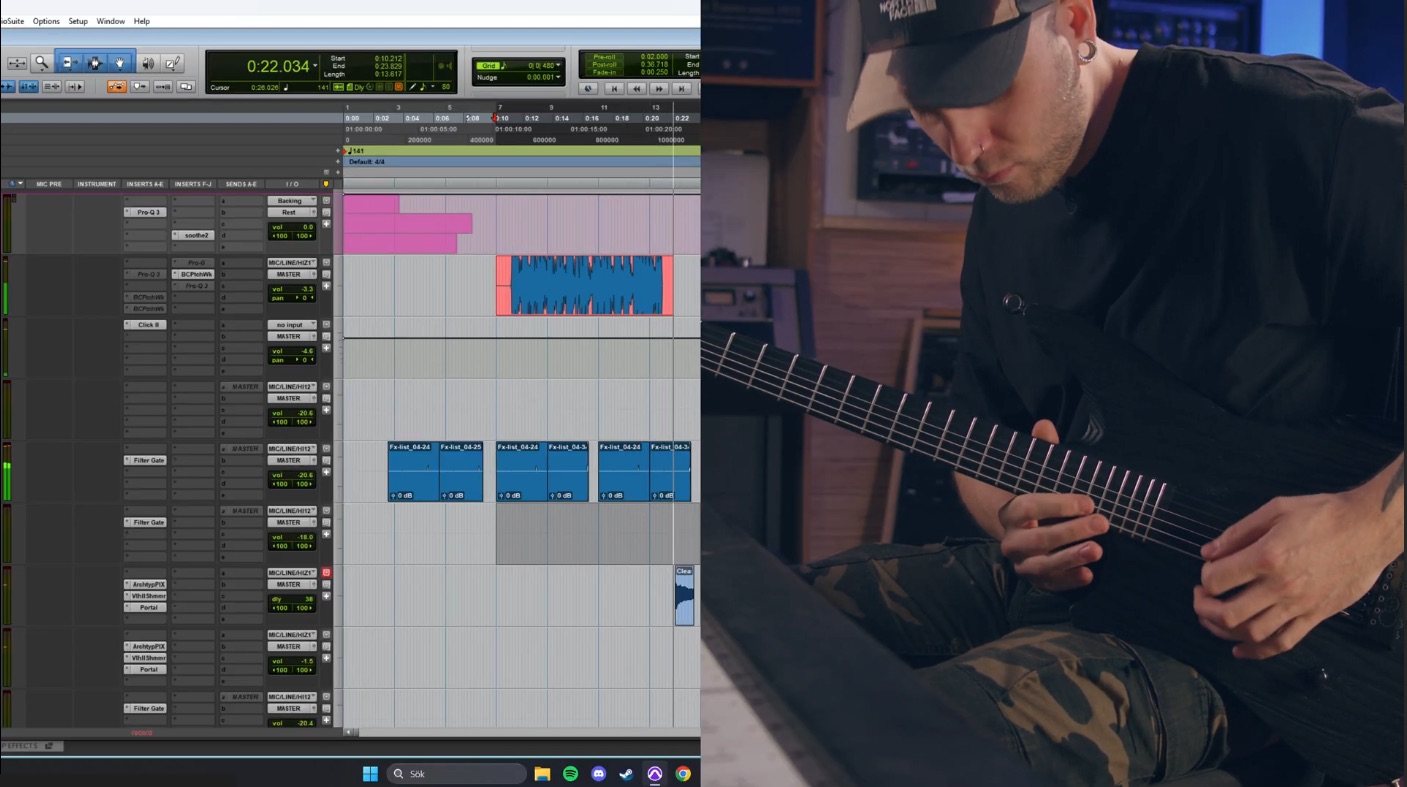
Mastering Engineering: Finalizing A Metal Mix
Nail The Mix Staff
Alright, so you’ve poured your blood, sweat, and probably a few tears into crafting a metal mix that absolutely slams. The guitars are chugging, the drums are pounding, the vocals are tearing through. But before you unleash it on the world, there’s one crucial step left: mastering engineering. This ain’t just about making it loud; it’s about giving your track that final polish, power, and consistency that makes it stand shoulder-to-shoulder with pro releases.
Forget fuzzy, undefined masters or tracks that sound wimpy next to your favorite bands. We’re diving into how to approach mastering engineering specifically for metal – keeping the aggression, dialing in the clarity, and making sure your tracks hit HARD.
So, Your Metal Mix Slaps. Now What? Prepping for Mastering
Before you even think about slapping a limiter on your master bus, hold your horses. The quality of your master is overwhelmingly dependent on the quality of your mix—it’s the fundamental rule when it comes to mixing vs. mastering. Garbage in, garbage out, as they say.
Headroom: Give Your Master Some Breathing Room
This is non-negotiable. Your final mixdown, the one you’re sending to mastering (even if you’re mastering it yourself), needs headroom. This means the loudest peaks of your song should NOT be hitting 0dBFS (decibels Full Scale).
Why? Mastering engineers (that’s you, in this case!) need that space to apply EQ, compression, and other processing without instantly clipping and distorting everything.
- Actionable Detail: Aim for your loudest peaks to be around -6dBFS to -3dBFS. If your mix is already kissing 0dBFS, pull down all your track faders (or your master fader, though track faders give more granular control if you group them) until you hit that target. Don’t just slap a gain plugin on the master and turn it down – that doesn’t fix inter-sample peaks that might already be there.
The Final Mix Check: Don’t Polish a… Well, You Know
Listen to your mix one last time with fresh ears. Is anything poking out weirdly? Is the bass muddy or clashing with the kick? Are the cymbals too harsh?
- Actionable Detail: Address these issues in the mix. Don’t rely on mastering to fix fundamental balance problems. Mastering is the icing, not the cake batter. Ensure there’s no clipping on your master bus or individual tracks. A clean, well-balanced mix is your best friend.
Your Metal Mastering Engineering Toolkit: The Signal Chain
There’s a somewhat standard signal flow for mastering, but as you’ll see in any pro’s in-the-box metal mastering chain, these are guidelines, not rigid laws. Your ears and the needs of the track should always dictate your choices.
Typical Order of Operations (But Rules Are Meant to Be Bent)
A common mastering chain might look like this:
- EQ (Subtractive): To clean up any problem frequencies.
- Compression: To glue the mix, add punch, and control dynamics.
- EQ (Additive): To sweeten and enhance the overall tone.
- (Optional) Saturation/Exciter/Stereo Widener: For character, vibe, or perceived width. Use sparingly!
- Limiter: To bring the track up to competitive loudness.
- Metering: Throughout and at the end of the chain.
Essential Plugin Categories (And Some Favorite Tools)
You don’t need a million plugins, but a few high-quality ones will do wonders.
- EQs: FabFilter Pro-Q 3 (a surgical godsend), Pultec emulations (like the Waves PuigTec or Universal Audio EQP-1A for broad, musical strokes), Maag EQ4 (for that sweet "Air Band").
- Compressors: SSL G-Bus style comps (Waves SSL G-Master Bus Compressor, Cytomic The Glue – classic rock/metal glue), API 2500 (punchy!), Shadow Hills Mastering Compressor (versatile and classy).
- Limiters: FabFilter Pro-L 2 (super versatile), Waves L2 or L3 Ultramaximizer (oldies but goodies), iZotope Ozone Maximizer (tons of control).
- Metering: Youlean Loudness Meter (free and fantastic!), iZotope Insight 2, Voxengo SPAN (free spectrum analyzer).
EQ: The Scalpel and the Sweetener for Your Metal Master
Mastering EQ is usually about subtle moves. We’re not trying to reinvent the tonal balance of the mix, just refine it.
Subtle EQ Moves, Massive Impact
Think broad strokes for sweetening and narrow, surgical cuts for fixing problems.
Cleaning Up the Low End: Tightness Without Thinness
Metal needs a powerful low end, but mud is the enemy.
- Actionable Detail: Use a high-pass filter (HPF) on your master. Start around 25-30Hz with a gentle slope (12dB/octave). This removes useless sub-rumble that just eats headroom. You might be surprised how much tighter this makes things without losing perceived bass. For specific muddiness, look for culprits between 150-300Hz and make a very slight cut with a plugin like FabFilter Pro-Q 3 if needed.
Carving Space and Adding Bite in the Mids
Guitars, snare, and vocals live here. Clarity is key.
- Actionable Detail: If guitars feel a bit buried or the mix lacks aggression, a tiny, broad boost around 1.5kHz to 3kHz can help. Be careful – too much here makes things harsh and fatiguing. Sometimes a small cut in the 400-600Hz range can clear up "boxiness."
Air and Clarity vs. Ice-Pick Highs
You want sheen and detail, not ear-splitting treble.
- Actionable Detail: A gentle high-shelf boost (e.g., +0.5dB to +1dB) above 10-12kHz with something like a Pultec emulation or the Maag EQ4's Air Band can open up the master. If cymbals are too washy or harsh, you might need a dynamic EQ or a very targeted cut in the 6-10kHz range before your broad high-shelf boost.
For more deep-dive EQ strategies, especially for carving out space in a dense metal mix, check out our EQ hub page.
Compression: Gluing and Punching Up Your Metal Master
Master bus compression in metal is often about adding "glue" – making the track feel more cohesive – and enhancing punch, rather than aggressive dynamic squashing. It’s the final master bus polish that can bring a mix to life.
Gentle Squeezing for Cohesion and Energy
We’re typically talking 1-2dB of gain reduction, maybe 3dB on loud sections if it sounds good.
Attack and Release: Shaping the Transient Impact
These are your money settings.
- Actionable Detail: For punch, try a slower attack (e.g., 30ms on an SSL-style comp) to let initial transients through, and a faster release (e.g., 100ms or auto-release) to bring up the body of the sound. For more "glue" and smoothing, a faster attack (1-10ms) and slightly slower release can work. Experiment!
Ratio and Threshold: Less is Often More
- Actionable Detail: Low ratios are common in mastering: 1.5:1 or 2:1 are good starting points. Set your threshold so you’re just tickling the compressor on the loudest parts.
Metal-Approved Master Bus Compressors
- SSL G-Bus style (e.g., Waves SSL G-Master, Cytomic The Glue): The classic "glue" for rock and metal. Known for making things sound punchier and more cohesive.
- API 2500: Can be more aggressive and punchy. Great for adding attitude.
- Shadow Hills Mastering Compressor: A beast. Can be super transparent or very colorful. The dual-stage compression (Optical then Discrete) offers amazing control.
Multiband Compression: Handle With Care!
Multiband compression (like FabFilter Pro-MB or the dynamics module in iZotope Ozone) can be a lifesaver for taming an unruly frequency range (e.g., a boomy kick that only gets out of control on certain hits). But it’s also easy to mess things up. Use it surgically—like when you need to control boomy low-end on guitars—and with extreme caution.
Want to get beyond just making things loud with compression? Our metal compression hub page has more secrets.
Limiting & Loudness: Making Your Metal Heard (Without the Casualties)
This is the final stage of gain, bringing your track up to commercial loudness levels. The debate between limiting vs. clipping for mastering is a deep one, but for now, we’ll focus on the primary tool: the limiter.
The Art of Getting Loud: Maximizers and Limiters
The goal is loudness without audible distortion, pumping, or loss of impact.
Pushing Your Limiter: Finding the Sweet Spot
- Actionable Detail: Load up your limiter (FabFilter Pro-L 2, Waves L3, Ozone Maximizer are all solid choices). Start increasing the input gain (or lowering the threshold) while watching your gain reduction meter. Listen very carefully. Most modern limiters have different "styles" or algorithms (e.g., Pro-L 2's "Aggressive," "Punchy," "Transparent"). Experiment to see what suits your track. For metal, something that retains punch is often desirable.
True Peak and Why It Matters
- Actionable Detail: Set your limiter’s output ceiling to -1dBTP (True Peak) or even -1.5dBTP. This prevents inter-sample peaks that can occur during digital-to-analog conversion, which streaming platforms really don’t like. Most modern limiters have a True Peak limiting option.
LUFS: Navigating the Loudness Landscape
Loudness Units Full Scale (LUFS) is the standard for measuring perceived loudness. Streaming platforms have target LUFS levels (e.g., Spotify aims for around -14 LUFS integrated).
- Actionable Detail: While metal often gets mastered hotter than -14 LUFS (sometimes -10 to -8 LUFS integrated isn’t uncommon for aggressive genres), be aware that platforms will turn down overly loud tracks. Use a LUFS meter like Youlean Loudness Meter to check your integrated LUFS. Don’t sacrifice your dynamics solely for a super high LUFS number.
Reference Tracks: Your Loudness & Tonal Compass
This is HUGE. Compare your master to commercially released tracks in a similar metal subgenre. How does your loudness stack up? How’s the tonal balance? This keeps your mastering decisions grounded in reality.
Metering & Monitoring: Don’t Fly Blind (Or Deaf)
Your ears are the ultimate judge, but accurate monitoring and visual metering are essential tools to help your ears make the right calls.
Your Ears Are #1, But Your Room Might Be Lying
If your room has weird acoustic issues (standing waves, dead spots), your mastering decisions will be skewed.
The Importance of a Treated Room (or Great Headphones)
- Actionable Detail: Acoustic treatment (bass traps, absorption panels) is ideal. If that’s not feasible, invest in high-quality open-back headphones known for mastering, like the Audeze LCD-X or Beyerdynamic DT 1990 Pro (the DT 990 Pro is a good budget option too). Even then, reference on multiple systems.
Room Correction Software
- Actionable Detail: Software like Sonarworks SoundID Reference can measure your room/headphones and create a correction curve, giving you a flatter, more trustworthy monitoring environment.

100+ Insanely Detailed Mixing Tutorials
We leave absolutely nothing out, showing you every single step
Essential Metering Plugins for Informed Decisions
- LUFS Meter: Youlean Loudness Meter, iZotope Insight 2.
- Spectrum Analyzer: Voxengo SPAN (free!), FabFilter Pro-Q 3 (has a great built-in analyzer). See what your frequency balance looks like.
- Correlation Meter: To check for phase issues that could mess with mono compatibility.
Common Metal Mastering Blunders (And How to Dodge 'Em)
Avoid these classic metal mastering pitfalls:
The Over-Compression Apocalypse
Sausage waveforms are bad. If your track has zero dynamic range and sounds squashed and lifeless, you’ve gone too far with compression and/or limiting. Ease back.
Sizzle vs. Fizz: Taming Harsh High Frequencies
Metal needs aggressive highs, but not ice-pick-in-the-ear harshness. Be careful with excessive high-end boosts, especially in the 5kHz-10kHz range. If you hear nasty "fizz," try a dynamic EQ or very precise surgical cuts before broad sweetening.
The Dreaded Mud Zone: Low-End Clarity
Too much un Dcontrolled low-mid energy (200-500Hz) or sub-bass can make your master sound muddy and undefined, especially on smaller systems. Keep it tight.
Summing It Up: Your Path to Brutal Masters
Mastering engineering for metal is a balancing act:
- Start with a great mix that has plenty of headroom.
- Use EQ subtly to clean up and enhance, focusing on low-end tightness, mid-range clarity, and smooth highs.
- Apply compression for glue and punch, not to squash the life out of your track.
- Push your limiter carefully to achieve competitive loudness without destroying dynamics or introducing distortion.
- Trust your ears, but verify with accurate metering and reliable monitoring.
- Reference, reference, reference!
These tips will give you a solid foundation for mastering your own metal tracks and achieving that professional, powerful sound.
Look, mastering is its own beast, and these pointers will definitely get you started on the right path. But what if you could see exactly how industry titans take a killer mix and push it over the finish line? Or even better, learn how they craft those killer mixes before they even hit the mastering stage? That’s where Nail The Mix comes in. It’s not just about watching – it’s about learning the entire process, from tracking to final master, on real songs from bands you actually listen to. If you’re serious about elevating your productions beyond just 'good enough' and truly want to unlock your sound mixing modern metal beyond presets, seeing how the pros do it, step-by-step, is invaluable. Go make some noise!
Get a new set of multi-tracks every month from a world-class artist, a livestream with the producer who mixed it, 100+ tutorials, our exclusive plugins and more
Get Started for $1



